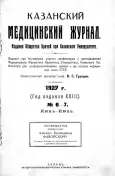Поражение почек при лечении висмутом. Lichtenberg (Derm. Woch., 1926, № 22)
- Авторы: Яснитский Н.
- Выпуск: Том 23, № 6-7 (1927)
- Страницы: 750-750
- Раздел: Статьи
- Статья получена: 31.07.2021
- Статья одобрена: 31.07.2021
- Статья опубликована: 15.07.1927
- URL: https://kazanmedjournal.ru/kazanmedj/article/view/77178
- DOI: https://doi.org/10.17816/kazmj77178
- ID: 77178
Цитировать
Полный текст
Аннотация
Lichtenberg отмечает тот интересный факт, что при одинаковых приблизительно дозах вводимого в организм висмута очень многие авторы наблюдали резкие колебания в частоте поражения почек. Сам он, подвергая систематическому анализу мочу 64 сифилитиков, леченных бисмогенолем, спиробесмолем и надизаном, в разных стадиях болезни, нашел что в 30% всех случаев имеются симптомы поражения почек, именно: эпителиурия, цилиндры (25%), белок (20%), эритроциты.
Ключевые слова
Полный текст
Lichtenberg отмечает тот интересный факт, что при одинаковых приблизительно дозах вводимого в организм висмута очень многие авторы наблюдали резкие колебания в частоте поражения почек. Сам он, подвергая систематическому анализу мочу 64 сифилитиков, леченных бисмогенолем, спиробесмолем и надизаном, в разных стадиях болезни, нашел что в 30% всех случаев имеются симптомы поражения почек, именно: эпителиурия, цилиндры (25%), белок (20%), эритроциты. По мнению автора, эпителиурия является первым несомненным признаком поражения почечной ткани, требующим немедленного прекращения висмутовой терапии L. настойчиво рекомендует поэтому производить у каждого больного систематическое исследование мочи во время курса лечения.
Список литературы
Дополнительные файлы







